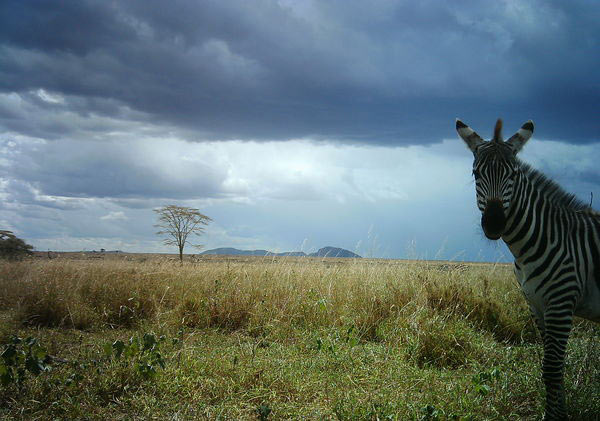Africa’s Serengeti conjures up romantic images of millions of migrating wildebeest and zebras, prides of lions feasting on their prey, and hyenas prowling in the background. But not everyone is fortunate to see them up close. Snapshot Serengeti, a citizen science project, is changing that.
It lets anyone, with or without a background in science or ecology, become a part of Africa’s wilderness from their homes. By identifying and classifying wild animals in camera trap photos, volunteers can satiate their love for nature, and in the process help researchers answer critical questions about Serengeti’s ecosystem. These images are part of a camera trapping survey operated by the Serengeti Lion Project, managed by researchers of the University of Minnesota.

Zebra. Photo by: Snapshot Serengeti.
In 2010, a team of researchers set up 225 cameras across the centre of Serengeti National Park, covering an area of about 1100 square kilometres. Since then, the team has completed eight seasons of their camera trapping survey, Alexandra Swanson, from the University of Oxford who set up the camera traps, said at the American Association for the Advancement of Science (AAAS) Annual Meeting in San Jose, California last month.
These cameras, which are triggered by a combination of heat and motion, generate over million images every year.

Lion. Photo by: Snapshot Serengeti.
Every photo tells a bit of Serengeti’s story, Swanson said. “But to turn them into scientific data, we need to know what animals are in the photo, how many there are, and what they’re doing. Unfortunately there were too many of them for me to do.”
So in 2012, Snapshot Serengeti was born as part of the Zooniverse Project, a platform for different citizen science projects.
On Snapshot Serengeti’s website, volunteers help tease out various details in the camera-trap photos: the animal’s identity, the number of animals in the photo, and its behaviour. And for people getting stuck, they can identify animals using patterns they see on the animal, its color, shape of its horns and tail and its build.

Wildebeest. Photo by: Snapshot Serengeti.
The task for volunteers is fairly simple. But how do the researches ensure that the dataset is reliable and good enough to answer ecological questions?
“We do two things to get the best data possible,” Swanson said at the meeting. “We send every single photo to many different people and we don’t let those people say ‘I don’t know what that is’ or that an image is ‘impossible to classify’.”
That annoys some people, she added, because some images are legitimately impossible. “Some people also say I don’t want to hurt your dataset. But actually it is OK to make mistakes. Even experts make mistakes.”
So by not letting people say ‘I don’t know’, and not penalizing them for making mistakes, the team gets a bigger set of raw data to work with. This gives them a ton of information, Swanson said.
 Cheetahs. Photo by: Snapshot Serengeti.
Cheetahs. Photo by: Snapshot Serengeti.
For instance, the volunteers’ cumulative answers can tell which animals are hard to identify, and which pictures are challenging. The votes can also help narrow down the animals’ identities. Even disagreements over identities can provide valuable information to the researchers.
The millions of classified images are helping the team answer a number of critical questions about Serengeti’s complex ecosystem, such as how different carnivores and herbivores co-exist with each other, and how the predators and prey interact.
In fact, the camera trap images reflect the known populations of Serengeti’s large mammals, according to Swanson. And over time they reflect the change in Serengeti’s ecosystem.
“You see herbivores, you see the migration coming through, and you see the carnivores following the herbivores. You even see the grass growing,” Swanson said.

Giraffes. Photo by: Snapshot Serengeti.

African landscape. Photo by: Snapshot Serengeti.

Zebras. Photo by: Snapshot Serengeti.
Related articles
|
Tiger family photo surprises scientists (03/10/2015) In a frigid Russian forest, a camera trap snapped 21 family photos over two minutes. This wasn’t a usual family, though, this was a tiger family, more specifically an Amur tiger family. And this wasn’t even a usual tiger family: the cameras showed a dad leading the way. |
|
Photos: Amur leopard population hits at least 65 (02/26/2015) Most of the world’s big predators are in decline, but there are some happy stories out there. This week, WWF announced that the Amur leopard population has grown to a total of 65-69 cats. This represents a more than doubling of the population in eight years. Still, the Critically Endangered subspecies remains perilously close to extinction. |
|
Super-rare carnivore photographed in Yosemite after missing for nearly a century (02/03/2015) For years, biologists believed the Sierra Nevada fox was down to a single population of around 20 animals in California’s Lassen Volcanic National Park. But then in 2010, biologists found a small population near Sonora Pass. Now, more good news: last week, scientists documented the first Sierra Nevada fox in Yosemite National Park in nearly 100 years. |
|
Adorbs: scientists capture first photos of African golden cat kittens (01/28/2015) The African golden cat is arguably the continent’s least known feline, inhabiting dense tropical forests, almost never seen, and, of course, long-upstaged by Africa’s famous felines. But a few intrepid scientists are beginning to uncover the long-unknown lives of these wild cats. Researchers working in Uganda’s Kibale National Park have captured remarkable photos of African golden cats…with kittens. |



